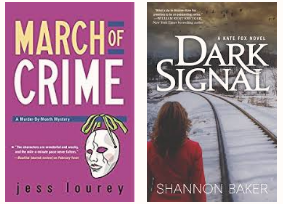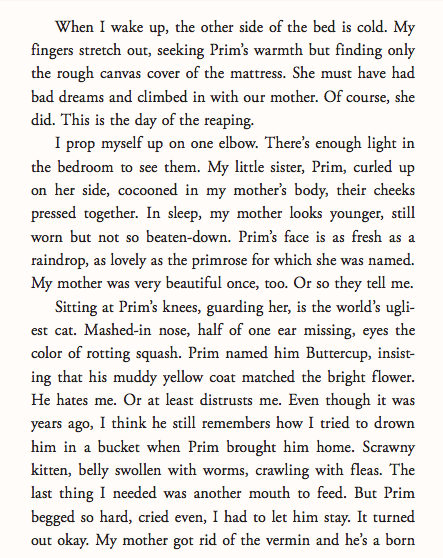Whose Line Is It Anyway? Mastering Deep POV (+ Giveaway!)
By Guest | September 24, 2017 |
Please welcome Jess Lourey (rhymes with “dowry”) and Shannon Baker back to WU today!
Jess and Shannon have written over 20 books between them, and are currently on their second national blog tour, Double-booked Round Two. Shannon is promoting Dark Signal, the second in the Kate Fox series (Longmire meets The Good Wife) and Jess is promoting the 11th book in her funny Murder-by-Month series, March of Crime.
A little more about them:
Jess is best known for her critically-acclaimed Murder-by-Month mysteries, which have earned multiple starred reviews from Library Journal and Booklist, the latter calling her writing “a splendid mix of humor and suspense.” She is a tenured professor of creative writing and sociology, a regular Psychology Today blogger, a sought-after workshop leader and keynote speaker who delivered the “Rewrite Your Life” TEDx Talk, and the author of Rewrite Your Life, the only book out there which shows you how to turn your facts into healing, page-turning fiction. You can find out more at www.jessicalourey.com, and by following her on Twitter.
Shannon is the author of the Kate Fox mystery series (Tor/Forge). Set in the isolated cattle country of the Nebraska Sandhills, Kirkus says, “Baker serves up a ballsy heroine, a colorful backdrop, and a surprising ending.” She also writes the Nora Abbott mystery series (Midnight Ink), featuring Hopi Indian mysticism and environmental issues. Shannon makes her home in Tucson where she enjoys cocktails by the pool, breathtaking sunsets, a crazy Weimeraner, and killing people (in the pages of her books). She was voted Rocky Mountain Fiction Writer’s 2014 Writer of the Year. Learn more about Shannon at www.Shannon-Baker.com and follow her on Twitter.
Today, Jess & Shannon will explore DEEP POV, which can help you connect more with readers. Enjoy!
Whose Line Is It Anyway? Mastering Deep POV
“The anger was long gone, doused in vodka and tamped down to a sour thud. But the memory of it wouldn’t fade. For a few hours there, everything had been clear. The rage was a high, pure note, sounding in your ears, slicing away the junk of life. It was a white light, vicious and merciless, showing the truth if you dared to open your eyes. It was a flashing blade, quicker and cleaner than anything.”
Or:
After a few drinks, I’d calmed down. I’d felt burning anger and it had made me realize the truth. I wouldn’t forget that for a long time.
I don’t need to ask which of these openings grabs you in the gut and makes your heart race. The first makes you feel, while the second tells you how the character feels, setting you, the reader, one degree removed from the story. A master of deep point of view (POV), Catriona McPherson opens her new book, House. Tree. Person. with that first quote.
What Is POV?
Shannon: My first lesson in point of view, after I learned the difference between first, second, third or omniscient, was the simple rule of picking one character per scene. And the notion to stay true to your point of view character so that the reader can only know or see what your point of view character knows and sees.
For instance, let’s say your POV character is Mabel and she’s married to Dirk. She loves Dirk and thinks he’s perfect. In this scene, she sees him hurry to get off the phone when she arrives and she thinks it’s because he loves her and wants to give his full attention to her.
In the next scene, we’re in Dirk’s POV and he’s not so in love with Mabel. He’s calling his mistress back and apologizing for having to hang up on her. The reader can see both points of view, but the character can’t.
If the first rule of POV means a writer can only put into a scene the perceptions of the character, as if the character’s brain is a movie camera and the reader is inside their head (think Being John Malkovich) then the idea of deep point of view is turning that camera around and seeing the inside of a character. This–deep point of view–is much harder.
What Is Deep POV?
Jess: Agreed. Deep POV was actually something I thought NOTHING about until I started working with Jessica Morrell, a freelance editor we share. I understood the same POV basics–write in first or third, stick to a single POV for your first few books (rather than head-jumping)–but had never heard of deep POV. According to Jessica, it showed in my writing. I often held readers at arm’s length rather than immersing them in the world through my character’s eyes. Deep POV, on the other hand, drops the reader deep into the character’s psyche, creating a sensory, indelible, and intimate experience. Deep POV is the difference between telling your reader that your character is embarrassed and making them feel the heat on their own cheeks.
Why and How to Go Deep
Shannon: There are simple and then more complex ways to create deep POV. For starters, with basic POV, the writer might use the phrase, “I saw (he saw, she saw).” In deep POV, that phrase is gone, because when you live your life, you don’t think, “I saw the doorknob turn. My heart beat against my ribs. I couldn’t breathe.”
Instead, you’re more like: “The doorknob turned. Maybe it was the babysitter and she’d have hot chocolate and we’d go watch ‘The Brady Bunch.’ But maybe it was something else, with claws not hands, saliva dripping from its fangs. If I moved, or even breathed, I was dead.”
Jess: Exactly. With deep POV, you remove the barriers between the experience and the reader. Essentially, write the scene as the character thinks/sees it by eliminating the dialogue tags or words that indicate reporting. Because deep POV still doesn’t come naturally to me, I search for these words in my manuscript and eliminate them whenever possible:
- Thought
- Felt
- Wondered
- Saw
- Knew
 When it comes to replacing those reporting words with expressive words, I recommend The Emotion Thesaurus. I always have that book by my side when I write. In addition to selecting more sensory words, to achieve deep POV, it’s important as a writer to drop into your character. Think of it like method acting for writers. If your character is feeling profound emotions, draw on your own experience feeling that emotion. Make yourself smell-taste-touch-hear-see your own experience with that emotion as you write that emotion so that it is bursting with firsthand immediacy.
When it comes to replacing those reporting words with expressive words, I recommend The Emotion Thesaurus. I always have that book by my side when I write. In addition to selecting more sensory words, to achieve deep POV, it’s important as a writer to drop into your character. Think of it like method acting for writers. If your character is feeling profound emotions, draw on your own experience feeling that emotion. Make yourself smell-taste-touch-hear-see your own experience with that emotion as you write that emotion so that it is bursting with firsthand immediacy.
It’s important to note that too much deep POV can be suffocating. Save it for high-tension moments in your story, and you’ll discover readers responding to those scenes at an insane level. Deep POV is definitely a tool every writer should have in their chest!
Shannon: I agree, and I don’t know why the deep POV concept took me so long to understand. One of my Ah Ha moments came when I read The Hunger Games, by Suzanne Collins. Check out the opening page. We see the world from Katniss’s point of view and immediately, we know she’s a protector and provider in a world of poverty and deprivation. In a matter of paragraphs! Without Suzanne Collins ever using any of those words.

Our best advice on point of view is to be aware of it, study it in great writing, and learn to use it to sink your readers so deeply into your story they never want to leave.
Jess and I are giving away three each of Dark Signal and March Madness on our Lourey/Baker Double Booked Tour. For a comment, you’ll be entered to win.
Do you struggle with Deep POV? Have questions, or any tips you’d like to share? The floor is yours.











Wow. This is exactly what is wrong when I try to write. It seems so stale. Now I see that my writing from POV of my characters has simply been exposition. It seems obvious now because this deep POV writing is what I am attracted to and what I used to pick out to read to my students to hook them on a book. Thanks.
So happy it was helpful, Karin! Discovering deep POV definitely transformed my writing. I think you’ll have the same experience.
I use deep POV and my CPs say I am good at it, but my problem is knowing exactly when to use it. Writing deep is exhausting so it makes sense that reading too much of it is suffocating.
Thanks for the tip on saving it for high tension moments.
You betcha, Carrie, and I know what you mean about it being exhausting to write that way. I think it’s healing and healthy, but it definitely takes an emotional toll in the moment.
I do too, Carrie, and yes very exhausting! apparently it’s the way my writer brain is wired, because when i tried to pull back to give some breathing room, i kinda stalled out! LOL
Deep POV is, without a doubt, the hardest to write and the hardest to understand. Your examples are wonderful. I think reading the differences between POVs, especially when considering Deep POV, is the best teacher, at least for me.
I’m currently writing (well, editing) a novel in which I want to evoke a heightened sense of emotion, especially in certain scenes. So Deep POV is a technique I need to use, but the hardest to implement. But, isn’t that true with most things?
Excellent post!
Michelle
“So Deep POV is a technique I need to use, but the hardest to implement. But, isn’t that true with most things?” Yes yes yes. Thanks for stopping by, Michelle, and sharing your experience and insight.
You both get the DONALD MAASS CLARITY OF EXPLANATION AWARD. A very good post with excellent examples of your point. Like so many techniques of the craft, intimate POV can be overdone, but when used sparingly, and at the right juncture, it makes the difference between adequate and gripping. Thanks.
Fredric, I’m a geek for gold-star style awards, so thank you. YAY!!!! Except Shannon was the one who came up with the examples. Sigh. Thank you for stopping by.
Excellent post. There’s not enough written on deep POV and how/when to use it. I work at ensuring I use it during tense moments within a story, but it’s so easy to allow reporting words to sneak in. I hope we’ll hear more intelligent discussion about this topic.
Charlotte, I agree that deep POV is under-discussed and over-needed. Thank you for taking part in the discussion!
Excellent post on utilizing POV to immerse readers in a character’s experience–I’ll be sharing this with my readers at Flogging the Quill. As an editor, I’m always on the alert for what you call “reporting words” (I’ve come to think of them as “filter” words that distance the reader, but I sorta like “reporting” better). I think your “Hunger Games” example is spot on. There are those who might say “Yeah, but what’s the story about?” The answer is right there–the character’s nature and drive to protect and provide, the characteristic that drives her every action throughout the series. Thanks.
Well said, Ray. Thank you!
Thank you. I especially liked your advice about using deep POV but doing so sparingly and eliminating reporting words. I have a tendency to overuse these words and your post tells me why this feels wrong to me and how to fix it. I concur with the use of The Emotion Thesaurus also, especially when editing.
Thank you, Pat!
Along comes your post just when I need to dive deeper. I was re-writing my main protagonist chapters in the first-person POV but there was no justification to change her from 3rd person. Deeper 3rd works far better and I’ve already done some shorts that way. With your advice, I can improve my writing – thank you.
That’s what we’re here for! Thanks so much for making us feel useful.
Hi, Jess & Shannon:
First, Jess, so lovely to see you here again. Your posts are always so worthwhile and enjoyable. (And thanks for using Catriona’s opening as an example.)
I love the term “Deep POV.” So much less wonky than “Free Indirect Discourse.”
The trick in its usage often lies in the transition from a somewhat more removed third person (where reporting words are more appropriate) to inside-the-character’s-mind. Done badly, the effect can be as jarring as moving from omniscient-objective to third person close–i.e., jumping from a bird’s eye view to a spot between the character’s ears.
Very often that transition can be slyly done with a movement from an exterior event, to the character’s initial recognition or physical response, to the more personal and interior reaction. Or embedding in the presentation of that exterior event, through voice, the POV character’s implicit appraisal or (mis)understanding of it.
Shannon: That intro to The Hunger Games is the gift that just keeps giving. Not so long ago Don Maass on this blog used the opening paragraph to show how to use both empathy and intrigue to draw the reader in. It’s really a masterful opening.
All of these examples reveal the merits of including in the narration the POV character’s implicit reactions, judgments, suspicions, etc., to give the external the immediacy of the internal.
Done well, it refutes the claim that first person is automatically more intimate than third. This technique closes that purported gap to a whisker.
Thanks so much for joining us. Wonderful post.
David — Catriona’s opening is only the beginning of masterful POV throughout the whole book (and previous works). She’s truly a master worth studying. And I agree about the Huger Games. So much to learn from those few pages!
You make such good sense about moving back and forth between deep and a little distant. And knowing when to go deep. POV is like a good marriage that way, you’ve got to give it a little space or you suffocate!
I have never seen this addressed before. I have heard the term ‘writing journalistic’, or ‘not enough empathy’, or ‘too distant’, etc, and I believe they are key terms that describe exactly what you are addressing here with the deep POV. Thank you. This has been of tremendous help.
So glad to hear it was helpful, Rosetta!
Your examples are wonderful. I just finished a great story with a large cast of characters, full of action and suspense, but the head-hopping left me outside the characters. Even if the author had used a single viewpoint per scene, there was too much telling. Thank you both for such a good lesson in deep-pov.
Vijaya, you make an interesting point about how deep POV sometimes gets sacrificed in service of action/suspense. Will have to keep that in the forefront of my mind as I write this thriller…
Oh, my, so much to learn. I think my characters’ POVs (yes, plural, I confess) are deep enough–but are they? I’ll go back and read with all this in mind. Surely I’ll find places where they can use more depth.
Deep POV, used judiciously, is a great editing element, Anna. Thank you for stopping by, and for commenting!
Good stuff!
Love the Minnesota connection :-)
It’s better than a Minnesota accent, amirite? ;) Thanks for hanging out with us, Tom!
Minnesota is just Nebraska without the Huskers, right?
Funny but so wrong shannon!
MN Fun fact – more shoreline than any state in the lower 48 (including coastal states) 😎
“Deep POV is the difference between telling your reader that your character is embarrassed and making them feel the heat on their own cheeks.”
This explains it so well. I need to remember more sensory details in my writing. Thanks for such a helpful article.
Glad it was helpful, Theresa! Thanks for stopping by.
Love this post. I’m preparing to teach a session on deep POV at a writers’ guild. The first time I heard about deep POV was from a literary agent who set me to task revising Chapters 1-3 of my debut. Wow. What a difference it made! I know the purpose is to make the reader “feel,” but I feel my characters even more when I’m writing deep POV. As I read through the comments of those who are just now learning about it, I was so excited for them. :) I’m a little nerdy that way, but it’s exciting to know their writing is about to be elevated to a new level!
Karen, I feel the same way. It’s exciting to know that some writers are going to have a whole new tool in their chest. How great that you get to share it with a local writer’s guild! Best of luck.
Perhaps those of us who are of a greater age (ahem) struggle more with deep POV because we grew up with third person omniscient, for the most part. I grew used to intuiting the characters’ emotions from small hints on the page, which in turn became the powerful parts of the story for me. I have come to appreciate deep POV, but I still like it done with a light hand, or at least a deft hand. I appreciated your caution to use deep POV judiciously, at the most appropriate moments, to avoid reader exhaustion. Thanks for a great–and useful–post!
That’s a great point, Edith, about writing tastes being generational, and about there being something to be said for making readers work a little bit. Thank you for stopping by and sharing your insight!
This sounds like filtering from Emma Darwin. https://emmadarwin.typepad.com/thisitchofwriting/2016/07/filtering.html
She delightfully refers to it as HD for your writing. Not only does it increase emotion, it also make the writing shorter.
Thanks for the link to that great article, David. Read the whole thing, and I agree, deep POV and what she calls HD for writing and what Burroway calls filtering are all the same concept.
The best explanation of deep POV I’ve read with outstanding examples. Thanks, ladies.
Thanks Judythe. Now, to execute it, there’s the challenge!
This is the number one thing I see when I do critiques. Thanks for the great article to share!
Wow! This is Brilliant! Best explanation ever. And at the right time too. I’m struggling with this now. Thank you.
Great tips. Thank you so much!
I think I use deep pov sometimes, but now I want to re-edit my most recent ms! Eye-opening!
I seem to be able to do deep POV in occasional paragraphs or drabbles (100ish word stories), but my biggest issue is moving the story along while trying to keep POV.